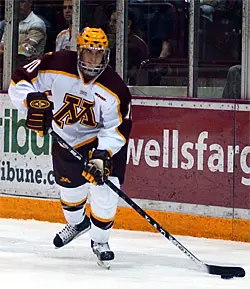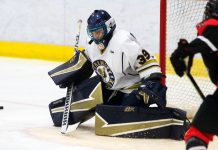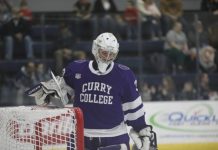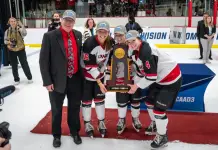On a week-to-week basis in the NCAA, it has been consistently shown that the team that scores more power-play goals in a game wins 65 to 75 percent of the time.
Stats can be manipulated to show anything to anyone, but this one is hard to twist. 75 percent is a big number. If you go 1-for-10 on the power play and your opponent goes 0-for-4, you have a great chance of winning. When you see 1-for-10 in the box score, you think that team had a bad night on the power play.
However, if the one they scored made a difference in the game, you had a good power-play night, and that is the nature of the power-play beast. Especially if the penalty kill pitched a shutout.
In hockey today, the power play has never been more important. With the stepped-up rules enforcement now well into year number two, and any use of the stick being penalized more, teams have been seeing plenty of time five-on-four, five-on-three, and four-on-three. Having seen 20 or 25 different NCAA teams practice this season, it is not hard to see that the power play has become more specialized.

Two things have always been paramount when it comes to the power play; fundamental skills and work ethic. That can be expounded on in many ways, but it really is the base on which to lay a power-play foundation.
At the NCAA level, one power play stuck out in my mind last season: Minnesota’s unit of Phil Kessel, Danny Irmen, Ryan Potulny, Alex Goligoski, and Chris Harrington. All five guys had great fundamental skills, all could shoot, pass, receive cleanly, and skate well.
Potulny, a right shot on the left side, could corral loose pucks anywhere and get himself off the wall and in position to use his laser wrist shot. His accuracy was impressive. Kessel was a sniper, and could, from the bottom of the left-wing circle, be counted on to bang home rebounds or take a pass and quickly get it past goalies. Irmen was the puck-getter, and very few chased and recovered loose pucks like he did. He also had great hands for an NCAA player and could score.
The two D’s, Goligoski and Harrington, could lug pucks up-ice, passed very well and recognized options from the back line as well as anyone. Both could one-time passes, both could score from up high, and both knew when to shoot, when to pass, and when to just get it netward and let the forwards do the rest. It was unique because all five guys could score on a one-timer.
This season, many units have shown they can take over a game. While Wisconsin has struggled, Andrew Joudrey (a forward who plays the left point) has shown a forward can quarterback a power play effectively. With the Badgers using the jam play from the left-wing side as their bread and butter, Joudrey has shown great chemistry with Ross Carlson in the left corner to create quick plays to the net.
Jake Dowell is the horse in front and has scored his share of the ugly goals, while Jack Skille provides the big wrister from the right-wing side. Jamie McBain has demonstrated good instincts as he moves up and down from his position on the right point to lower areas of the offensive zone.
Mike Cavanaugh runs a Boston College power play that features size, speed, and hands. Brian Boyle works the slot, all 6-foot-7 of him, and smaller skill forward Joe Rooney runs the half-boards. Bradford is the slot guy and has shown the same willingness as Irmen or Dowell to get to loose pucks.
Brett Motherwell, who has been okay but will be very good in this position next season when completely healthy, has a great shot from the point and good speed on the breakout. His recognition of options is improving. Benn Ferriero plays the other point and as a forward has added an element of great skill and instinct to the blue line.
“Cav feels the power play can get even better; it isn’t when he wants it to be right now,” BC head coach Jerry York said prior to the Eagles’ weekend in Vermont, a weekend during which they got swept by the Catamounts. “He feels that puck movement and accuracy when we shoot are our main concerns. They have to improve.”
So what makes a good power play? Back in 1994, the New York Rangers had an awesome power play that featured Mark Messier, Adam Graves, Alexei Kovalev, Sergei Zubov, and Brian Leetch all in their primes.
Asking one of the players on that team what the role of the coach who ran the power play was, his response was “to stay the hell out of their way.” Mike Keenan, the coach of that Stanley Cup team that destroyed teams on the power play, never practiced it. He let it be known that the power play belonged to the creativity of the players on it.
That was an elite group of five, four who’ll wind up in the Hall of Fame (Kovalev would be my bet not to make it). Most NHL teams, and just about everyone else on the hockey map, will practice the power play often. However, practice could be an exercise in futility if you a) do not have the right personnel, and b) have it too structured.
“The best skill is still hockey sense,” said Michigan State’s Rick Comley, who has won over 700 games and a national championship in college. “Giving complete freedom to constantly move and use the five-on-four advantage to create scoring opportunities makes a good power play.”
However, sometimes a simple rule helps guide a power play.
“Shawn Walsh had this rule that it was two passes and a shot,” said current Manchester Monarchs coach Mark Morris, who guided Clarkson to many successful seasons in his days behind the Golden Knights bench. “It created such a buzz in the building. Every one knew that big shot was coming. Pass-pass-shot. It was exciting.”
What goes into the power play? Coaches around the NCAA have made it resoundingly clear that before any strategy gets discussed, personnel gets decided. Criteria are established by the staff on what type of player plays the power play.
Do you take your five best pairs of hands, or would that put five forwards on the ice? Do you want a big man in front of the net? A forward at the point, or two D? Which forward has the best one-timer to play the back door, or does he shoot the same way as your best playmaker so that he’ll be a strong-side guy as opposed to the back-door guy? Size in front of the net? Might a big defenseman work in that role?
Lots of questions, lots of discussion. Lots of debate, and some of it gets heated.
“You need five players who can feel where the defensive pressure’s coming from. They have to be able to catch a pass, and move the puck smartly,” said York, who has had a pair of Giontas, a pair of Eaves, and a host of other NHLers on his power play at The Heights. “They all need to be capable of scoring and hockey sense is a big part of that.”
One power play that isn’t flashy but has been productive over the past few years is the one that practices at the Alfond Arena. The Black Bears of Maine keep it simple but are effective and have had the likes of Michel Leveille, Greg Moore, and Derek Damon to fuel their efficiency the past four years, two of which found them in the Frozen Four.
“You need someone who is comfortable at the net,” said head coach Tim Whitehead. “You need a big rig in front of the net who people might look at and feel would never be on the power play, but they are effective in that role and help your power play score.
“He might be a guy that doesn’t skate that well, but all of a sudden it is not a big issue and you find ice time for a guy who becomes a key guy. You become pleasantly surprised that someone could have an impact on your power play when you really didn’t know that they could do much there.”
However, what a power play needs more than anything is a quarterback. Names like John-Michael Liles, Brett Skinner, Matt Carle, Chris Harrington, and Jordan Leopold come to mind. The current players in those roles include Quinnipiac’s Reid Cashman, Boston University’s Kevin Schaeffer, Minnesota’s Alex Goligoski, and Harvard’s Alex Biega. All have big shots, can one-time it, move it smartly, and can create offense with a combo of speed, skill, and great puck skills.
“When you put your power play together, it’s imperative to have that real special QB up top,” said RPI head coach Seth Appert. Appert was an assistant at Denver during its back-to-back national titles, and was privileged to watch Skinner and Carle work together, and then watch Carle do it by himself.
“It makes the goaltender and top forwards honor that guy a bit more,” he said. “It means the penalty-kill forward has to come out a little further, and that opens up the passing lanes underneath. It allows the power play to use those lanes that are opening up to sneak passes through the box for better scoring chances.”
Mostly though, a good power play is one that keeps the puck and can make something out of nothing. The need to do the simple things like make good passes, hit the net, avoid blocked shots, attack with speed, two-on-one loose pucks, and react to what’s given are key components.
There is one key element that gets debated. While coaches like to think of their elite power-play guys as players who can think as coaches on the ice, there is one thing that they hope they don’t do too much of.
“I think that thinking is a bad thing,” said Dartmouth Coach Bob Gaudet. “I always try to get the guys to think less. So guys that can really react are crucial.”


